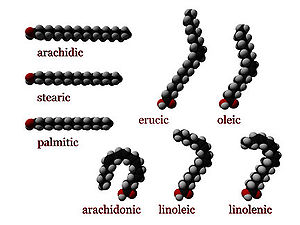Structures and Roles of Fatty Acids:
In chemistry and particularly in biochemistry the fatty acid is a carboxylic acid with a long aliphatic tail (chain) that is either saturated or unsaturated. Many obviously occurring fatty acids have a chain of an even number of carbon atoms from 4 to 28. Fatty acids are commonly derived from phospholipids or triglycerides. While they are not attached to other molecules they are called as free fatty acids.

Fatty acids are very important sources of fuel since, when metabolized, they yield large quantities of ATP. Several cell kinds can use either glucose or fatty acids for this reason. In particular, skeletal muscle and heart prefer fatty acids. The brain will not use fatty acids as a source of fuel it relies on glucose or ketone bodies.